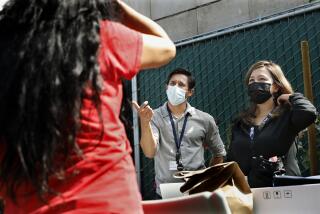TB outbreak is not just a skid row problem
- Share via
There’s a $200-million hotel on the drawing board for downtown Los Angeles, so tourists from around the globe can kick up their heels at LA Live.
And a few miles away on downtown’s skid row, there’s a TB outbreak brewing in a stew of Third World-style squalor and disorder.
It’s the yin and yang of our city’s clumsily evolving downtown scene: We haven’t managed to seal the deal for a professional football team, but we have been able to produce and sustain our own unique tuberculosis strain.
Times reporters Anna Gorman and Andrew Blankstein revealed the tuberculosis epidemic in an article last month. Twelve people have died and 78 infections have been treated — 61 of those on skid row — since the Los Angeles strain emerged five years ago.
Now federal officials are in town to help identify and track down more than 4,500 people who may have been exposed to the contagious illness.
That’s harder than it sounds. Most of those folks live or congregate on skid row, where close quarters, unsanitary conditions and high mobility make the airborne disease easy to spread and more difficult to treat.
But not to worry, health officials say: “The general public is not at risk. There is no danger to the general public.”
Los Angeles County Public Health rep Kristin Mundy made that point three times in her opening remarks at a Wednesday night meeting of the Downtown L.A. Neighborhood Council.
The “general public” means anyone lucky enough not to live on skid row.
But her pronouncement didn’t deliver much comfort to the people in that room. Most were not the general public, but skid row residents who’d shown up with lots of questions and paper masks strapped around their necks.
::
Their questions were not much different from what I would have wanted to know if TB were spreading through my neighborhood:
How do I stay safe? How will you stop the spread? And why did it take so long to share the news of an outbreak that’s five years old?
In a neighborhood as diverse as downtown L.A., there are bound to be different perspectives.
An Occupier hung around just long enough to accuse “the press and the government of using the news to vilify skid row.” A woman from nearby Little Tokyo wondered why police officers were advised to don masks but residents told not to. And a former skid row resident who now lives a few blocks away said the outbreak is bound to reach beyond the homeless and the poor.
Don Garza’s neighbors in downtown’s historic core are college students, middle-class young couples and folks like him, who pay their rent with government help. “We’re in constant contact with the skid row community,” he said. “We’re inextricably bound together.”
Public health experts are focusing their efforts on skid row shelters and medical centers, asking them to test clients and patients and be on the lookout for telltale symptoms — persistent cough, weight loss, bloody sputum — that suggest contagious infection.
But people who live or work on skid row say it’s naive to think the disease can be contained by focusing only on the homeless.
“The ‘contain’ word kind of bothers me,” said the Rev. Stephen “Cue” Jn-Marie, whose weekly gatherings on skid row corners draw volunteers from all over the city. “Whatever happens on skid row,” he said, “Los Angeles will feel it.”
::
We’re connected in ways we may not realize, and not just on downtown’s margins. The police officers, social workers, teachers in schools that serve skid row’s children, the clerks in the local stores ... They go home to Orange County, Pasadena, Van Nuys, Inglewood.
The idea that we can wall off skid row — a place many of us will never see — is a comfortable illusion, now punctured by disease.
And conventional methods to track public health threats may not be enough to stop the spread of the county’s worst TB outbreak in a decade.
“You’re looking for the mentally ill to come and tell you they’ve got TB? That’s not going to happen,” said Manuel Compito, a skid row resident and volunteer with Operation Face Lift, which sponsors weekly cleanups.
He wants attention paid to the circumstances that spawned and fuel this outbreak: inadequate healthcare, filthy streets, mental illness, drug addiction, financial instability.
So do doctors and activists who work with skid row’s residents. “Let’s not put a Band-Aid on this,” said Dr. V. Diane Woods, who has spent the past two years researching disparities in mental health treatment.
Woods thinks there ought to be mass testing and health officials working the streets.
“If this was a middle-class community, there would be more urgency,” said Woods. People would be tracked down and quarantined, instead of being gently urged to come in for tests or report peers who are coughing up blood.
“There’s a different conversation when it’s skid row,” Woods said. “People say ‘Those are just homeless people. They’re nasty, they don’t take care of themselves.’
“But TB is not a homeless disease,” Woods told the meeting Wednesday night. “The bacteria don’t discriminate. The host is any human in this room. Anyone can be at risk if they are in the presence of someone and they come in contact with a pathogen.”
Suddenly I wished I had one of those paper masks. My nostrils felt funny and I began to twitch any time someone around me coughed.
The county public health department plans to post a link to testing centers on its website, https://www.publichealth.lacounty.gov.
Tests are already being offered at the Central area health center, at 241 N. Figueroa St. in downtown Los Angeles.
More to Read
Sign up for Essential California
The most important California stories and recommendations in your inbox every morning.
You may occasionally receive promotional content from the Los Angeles Times.









